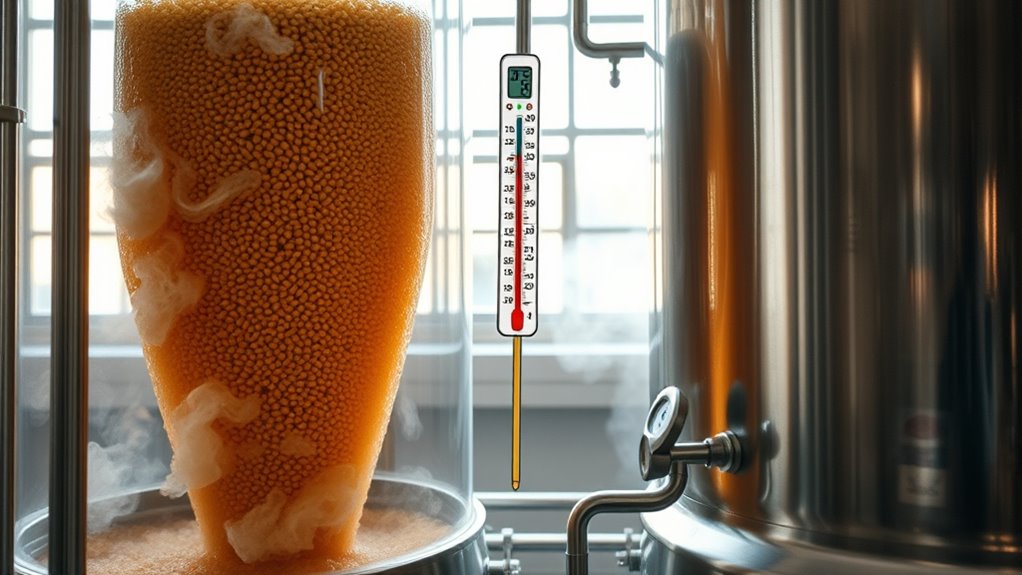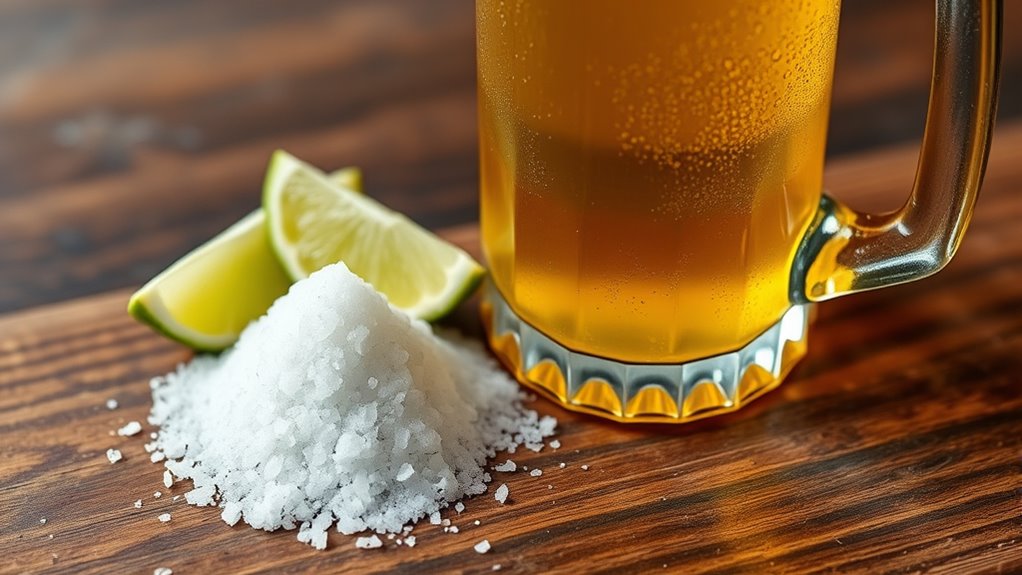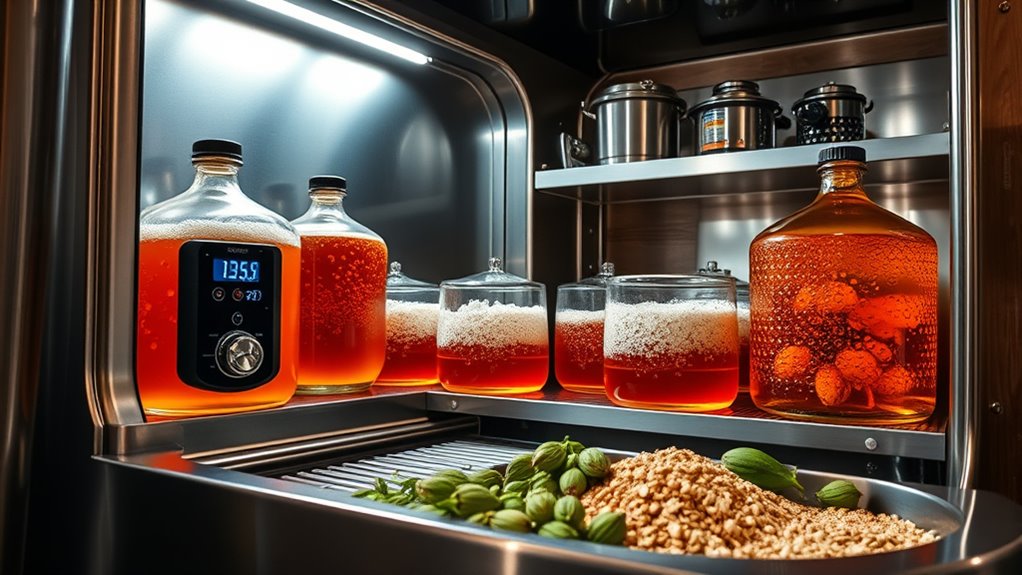To decoction mash your craft beer, start by measuring 1 to 1.5 pounds of well-modified malt per gallon. Mash your grains in hot water, then remove a portion of the mash to boil it for 15-30 minutes. Return the boiled mash to the main mash, adjusting temperatures for different mashing rests. This process boosts malt complexity and flavor. Remember, monitoring temperature is essential for success. Discover additional techniques and tips to perfect your decoction mashing process.
At a Glance
- Start by heating water to 120°F before adding milled grains for even hydration in the mash tun.
- Remove one-third of the thick mash for boiling, then boil it for 15-30 minutes to enhance flavors.
- Return the boiled mash to the main mash and adjust temperatures for subsequent rests to optimize enzyme activity.
- Use well-modified malts like Munich to ensure efficient starch conversion and rich malt character.
- Monitor rest temperatures closely to improve clarity, body, and head retention in your final beer product.
Understanding Decoction Mashing
When you’re brewing beer, understanding the process of decoction mashing can greatly enhance your final product. This decoction method involves removing part of the mash, boiling it separately, and returning it to the main mash. This technique optimizes protein rest and saccharification rest stages, efficiently converting starches into sugars.
During brew day, pay attention to boiling times, typically between 15 to 30 minutes, as longer times develop richer flavors through Maillard reactions. By enhancing malt complexity, decoction mashing is especially beneficial for styles like Bock, resulting in a beer with depth, color, and character that stands out in extract brewing.
Pay attention to boiling times; longer durations enhance flavors, making decoction mashing ideal for rich, complex beers like Bock.
Helpful Hints:
- Experiment with boiling times for flavor variation.
- Focus on temperature control during rests.
- Consider the style of beer you’re brewing.
Equipment Needed for Decoction Mashing
Decoction mashing requires specific equipment to achieve the best results, as the process involves several steps that need proper tools. Here’s what you’ll need:
- Brewing kettle: Essential for the initial mash and boiling the removed portion of grain.
- Mash tun: A container to hold and manage the mash, like a bottling bucket with a spigot.
- Cooking thermometer: Preferably with a probe, to monitor temperature increases for maximum enzyme activity.
- Mash paddle: Useful for stirring the mash and preventing clumping of grains.
Make sure you also plan your water per pound to achieve the ideal consistency. Additionally, investing in high-quality brew kettle products can significantly enhance your brewing experience.
Preparing Your Grains

Preparing the grains is a crucial step in the decoction mashing process, as it sets the foundation for effective starch conversion and flavor development.
Start by selecting well-modified malts, like Munich, ensuring efficient extraction. Measure about 1 to 1.5 pounds of grains per gallon of beer.
Mill the grains to a coarse consistency to prevent a stuck mash. Preheat your brewing kettle with the correct amount of water to around 120°F.
Then, use a mash paddle to stir the milled grains with the hot water, ensuring even hydration and eliminating clumps. This preparation is essential for a successful mash. Additionally, consider using base malts such as Golden Promise for their ability to complement hop profiles and enhance the overall flavor.
Helpful Hints:
- Keep your workspace organized.
- Use a thermometer to check water temperature.
- Be consistent with your measurements.
The Decoction Process Explained
Understanding the decoction process is essential for brewers looking to enhance the flavor and character of their beer. This innovative method involves several key steps:
- Remove a portion of the thick mash.
- Boil the extracted mash for 15-30 minutes.
- Return the decocted mash to the main mash.
- Adjust the temperature for subsequent mash rests.
This mashing process not only improves malt character but also enhances clarity, body, and head retention.
The benefits of decoction can markedly elevate your brewing process, allowing for more complex flavors and a richer final product.
Embrace this technique to truly innovate in your craft beer.
Temperature Control During Mashing

Temperature control plays a significant role during the mashing process, as it directly influences enzyme activation and sugar conversion.
Temperature control is crucial in mashing, impacting enzyme activation and sugar conversion effectively.
Start with an initial protein rest at around 50°C (122°F) for 20-30 minutes to enhance enzyme activity. Gradually increase the temperature, using your brew kettle to boil the first decoction. Aim for a mash temperature of approximately 68°C (155°F) to optimize the saccharification range.
During this process, monitor temperatures closely; avoid exceeding 70°C (158°F) to preserve enzyme activity. After the final decoction, adjust the mash temperature to 77°C (170°F) to halt enzyme activity before sparging. Maintaining a consistent temperature is crucial for achieving the best results.
Helpful Hints:
- Use a reliable thermometer.
- Plan your mash schedule carefully.
Benefits of Decoction Mashing
Decoction mashing offers several benefits that can greatly enhance the quality and character of your beer.
By employing techniques like the triple decoction mash, you can:
- Improve starch conversion efficiency, leading to higher sugar yields.
- Promote Maillard reactions for richer melanoidins, enhancing flavor development.
- Achieve better clarity and head retention in your craft beer.
- Create a more robust and satisfying final product, ideal for traditional styles like Bock.
This time-consuming method ultimately elevates your brewing process, allowing you to convert the starches effectively and produce a refined beer that stands out in flavor and appearance.
Common Challenges and Solutions
Brewing beer through decoction mashing can be rewarding, but it also presents several challenges that brewers need to navigate.
Maintaining Temperature: Use a reliable thermometer to track temperatures closely during each rest, preventing enzyme denaturation.
Timing: Plan your brew day, as a triple decoction may take up to six hours.
Boiling: Stir constantly with a long-handled spoon to avoid scorching the grains.
Separating the Mash: Use visual cues and measure accurately to boil the correct portion of the mash.
Tannin Extraction: Keep pH levels low during decoction to minimize unwanted tannins, ensuring a smoother beer. Additionally, maintaining a proper mash pH around 5.2 to 5.6 is crucial for optimal enzyme activity and beer quality.
Helpful Hints:
- Test pH regularly.
- Stay organized.
Variations of Decoction Mashing Techniques
When exploring variations of decoction mashing techniques, it’s essential to understand the differences between single, double, and triple decoction methods, as each offers unique benefits and challenges.
Here’s a quick overview:
- Single Decoction Mash: Efficient, requiring less time, and achieves desired sugar levels.
- Double Decoction: Involves two boilings, enhancing complexity and flavor.
- Triple Decoction: Traditional, labor-intensive, with three boilings for maximum sugar extraction.
- Boiling Times: Adjust based on beer style, from 15 minutes for lighter beers to 40 for darker ones.
Experiment with rest temperatures and the amount of grain to tailor your finished beer and refine your mashing method.
Tasting Notes and Flavor Profiles
The flavors you experience in decoction-mashed beers are a direct result of the unique mashing process that enhances the malt profile.
Decoction mashing enhances malt profiles, resulting in rich flavors and complexity in your favorite brews.
Decoction mashing promotes Maillard reactions, creating rich malty flavors and deeper colors. You’ll notice increased malt complexity, with higher melanoidin levels contributing to a smooth body and mouthfeel.
This technique also improves clarity and head retention, thanks to better hot break formation. Flavor profiles often showcase notes of breadiness and toasty characteristics, adding depth.
Traditional styles like Bock and Dunkel exemplify these traits, making decoction-mashed beers a delightful choice for innovative brewers aiming for exceptional quality. Additionally, this method reflects historical brewing techniques, ensuring that the final product honors the traditions of authentic German lager brewing.
Tips for Successful Decoction Mashing
Successfully decoction mashing requires careful attention to detail and a systematic approach.
To achieve good results, follow these tips:
- Always monitor your rest temperature, aiming for around 155°F during the saccharification rest.
- Remove a portion, about one-third, of the main mash for your first decoction.
- Boil the mash for 15-30 minutes depending on your beer type to develop flavors.
- Stir constantly during boiling to evenly distribute heat and avoid scorching.
Document your process, including time and temperatures, to refine your technique for the last decoction.
With practice, you’ll hold this liquid to create innovative and flavorful brews.





